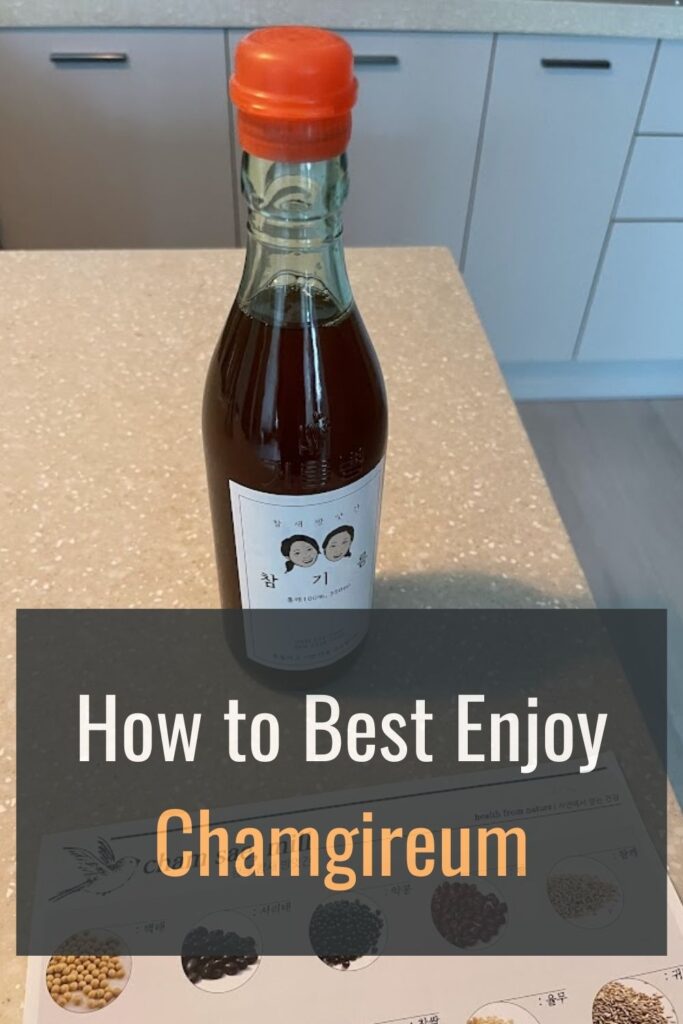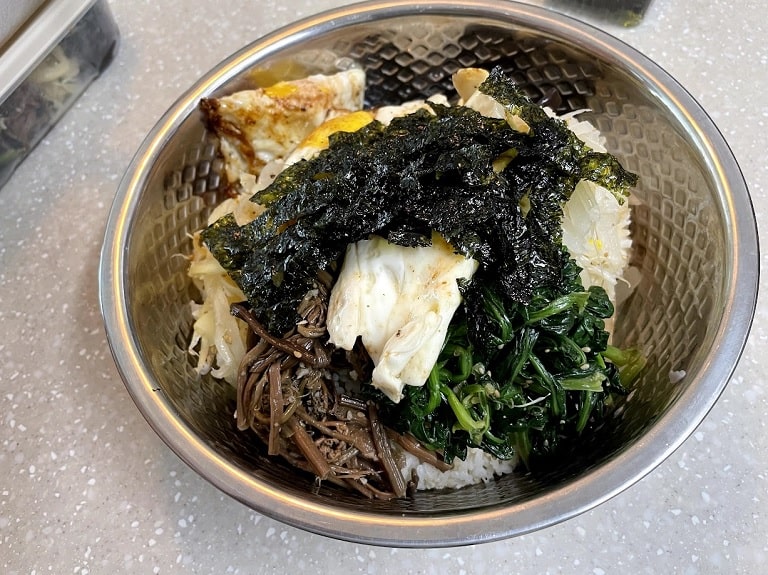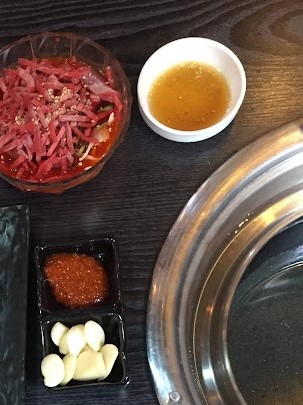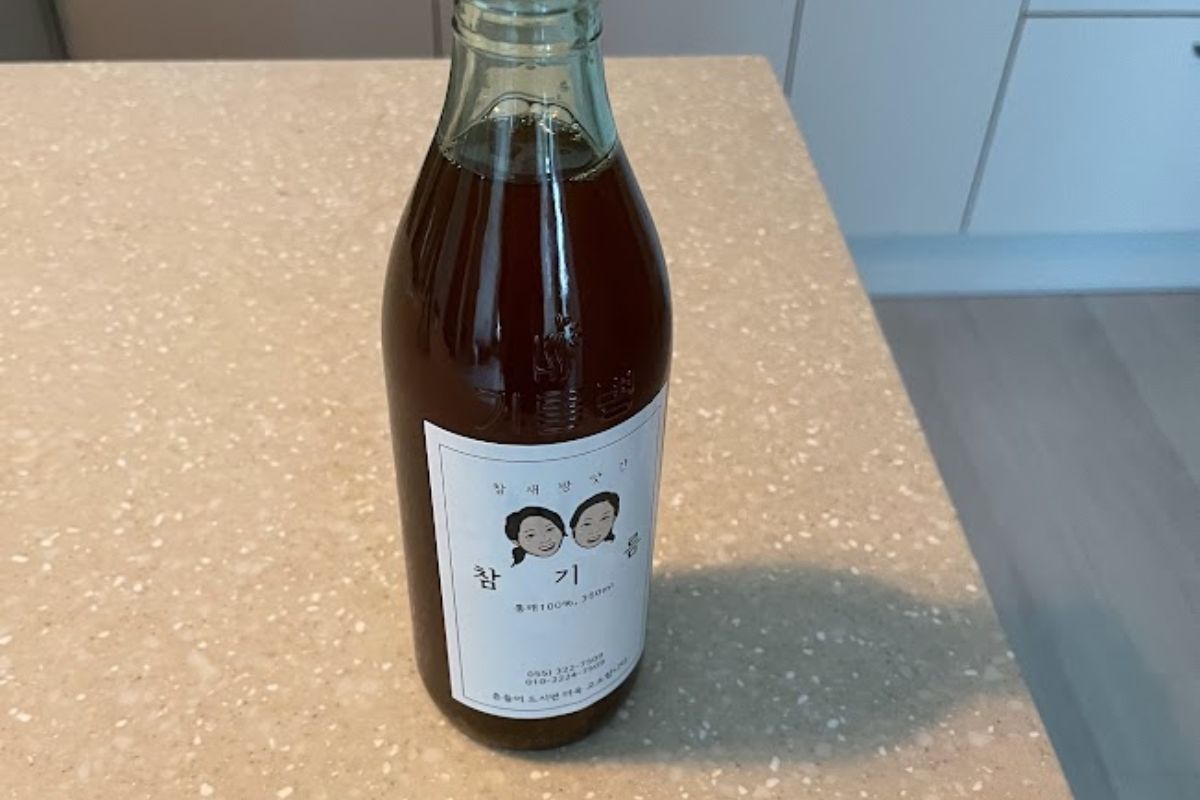Korean food isn’t the same without the magic ingredient, Chamgireum.
Here is everything you need to know about Korean toasted sesame oil, along with some easy recipes to bring that Koreanness home!

What is Chamgireum?
Also known as Korean toasted sesame oil, Chamgireum is a flavorful and aromatic oil derived from toasted sesame seeds. It holds a prominent place in Korean cuisine, revered for its rich nutty taste and deep aroma.
It’s a finishing oil that’s best enjoyed when added to fully cooked dishes.
Made by roasting sesame seeds and pressing them to extract the oil, Chamgireum adds a distinctive depth of flavor to a wide variety of dishes, from seasoned vegetables (Namul) and marinades to dressings and dipping sauces.
Its versatility and unique profile make it a staple ingredient in Korean cooking, beloved for its ability to enhance the taste of dishes while imparting a delightful fragrance.
Then, what is Deulgireum?

Deulgireum is another type of sesame oil commonly used in Korean cuisine. Deulgireum is an oil produced from perilla seeds, resulting in a more intense, richer and heavier flavor profile. My favorite ways to enjoy Korean Perilla oil are by frying eggs, grilling tofu, boiling seaweed soup, and seasoning vegetables for that extra nutty flavor.
4 Super Easy, Budget Recipes with Chamgireum
1. Soy Sauce Noodle Recipe
This recipe is perfect for a light lunch or guilt-free late night snack. If you’re on a tight budget this month or you don’t feel like grocery shopping, all you need is somyeon, soy sauce, and toasted sesame oil as the essential ingredients.
Ingredients:
- 2 servings of thin wheat flour noodles (Somyeon)
- 5 tablespoons soy sauce
- 2 tablespoons toasted sesame oil (Chamgireum)
- 1 tablespoon sugar
- 1/2 spoon of red pepper powder
- 1/2 spoon of salt
- 2 spoons of roasted sesame seeds
Instructions:
- Cook the noodles according to package instructions. Drain and rinse under cold water.
- In a bowl, mix together soy sauce, sesame oil, sugar, red pepper powder, salt and sesame seeds to make the sauce.
- Toss the cooked noodles with the sauce until well coated.
- Enjoy!
2. Egg Rice with Soy Sauce Recipe
Also known as Ganjang Gyeran Bap in Korean, which literally translates to ‘soy sauce, egg, rice’. This is my go-to when my fridge is empty, with all of my side dishes gone. It’s great for moms who want to take a break from a cookathon, or college students who need a simple recipe on a budget.
Ingredients:
- 1 bowl of steamed rice
- 2 eggs
- 2 tablespoons soy sauce
- 1 tablespoon toasted sesame oil (Chamgireum)
- 1 teaspoon sesame seeds (optional)
Instructions:
- Heat a skillet over medium heat with cooking oil.
- Crack the eggs into the skillet, and fry or scramble them according to your preference.
- Add the steamed rice to the skillet and stir to combine with the eggs.
- Pour the soy sauce and toasted sesame oil over the rice and eggs, stirring well.
- Mix them and garnish with sesame seeds (optional for the extra nutty flavor).
- Serve in individual bowl.
Tips!
If you want to keep it extremely simple, just fry the eggs, move them to a bowl of rice, add soy sauce and sesame oil, and mix them well. That’s it!
3. Bibimbap Recipe

I love healthy, delicious meals, and bibimbap fits those criteria perfectly. I believe that bibimbap is not complete without a spoon of Chamgireum!
Ingredients:
- Steamed rice
- Ground beef or thinly sliced tofu
- Assorted vegetables (such as spinach, carrots, bean sprouts, mushrooms)
- Soy sauce
- Toasted sesame oil (Chamgireum)
- Korean red pepper paste (Gochujang)
- Sesame seeds
- Fried eggs
- Dried seaweed flakes (Gim Garu)
Instructions:
- Cook each vegetable separately and season lightly with soy sauce and sesame oil.
- Cook ground beef or thinly sliced tofu in a pan until thoroughly cooked, season with a little bit of soy sauce and sesame oil.
- Arrange the steamed rice in a bowl and top with the cooked vegetables and beef or tofu.
- Place a dollop of gochujang on top of the bowl.
- Fry an egg and place it on top of the bibimbap.
- Add a spoon of toasted sesame oil.
- Sprinkle with sesame seeds and dried seaweed flakes.
- Mix everything together thoroughly before eating.
- Enjoy your homemade bibimbap!
Tips!
If you don’t want to cook the whole thing, you can simply stop by a Korean supermarket in K-town and buy assorted vegetables (namul). Then, all you’ve got to do at home is: make steamed rice, (fry an egg – optional), add those veggies, a dollop of gochujang and a spoonful of toasted sesame oil. I also love adding a handful of dried seaweed flakes (gim garu)!
4. Chamgireum Dipping Sauce

If you’re a fan of KBBQ, you’ve got to try the Chamgireum dipping sauce. This easy recipe will enhance the meat flavor, especially when you grill any type of unmarinated meat. It’s an extra flavorful experience to have one small dipping bowl of Ssamjang, and another of Chamgireum dipping sauce. This sauce also works really well with parboiled octopus too!
Ingredients:
- Sesame oil (Chamgireum)
- Salt
- Black pepper (optional)
Instructions:
- In a small sauce bowl, pour Korean sesame oil (as much as you want or 2 spoons).
- Sprinkle salt (and pepper – optional).
- Stir them a bit.
- Dip grilled meat and enjoy!

Other Questions You Might Have About Chamgireum
Q: Is Korean sesame oil different?
A: Yes, Korean sesame oil, or Chamgireum, is distinct due to its unique toasting process, which gives it a rich, nutty flavor compared to other varieties of sesame oil.
Q: What is the best sesame oil brand in Korea?
A: There are several reputable brands, but some popular ones include Ottogi, CJ, and Daesang. Ultimately, the best brand can depend on personal preference and intended use. My favorite is a non-branded, artisan sesame oil that is freshly extracted and directly purchased at a local mill.
Q: Why do Koreans use so much sesame oil?
A: Sesame oil is a staple in Korean cuisine due to its flavorful aroma and versatility. It adds depth and richness to dishes, enhancing their overall taste.
Q: Is Korean sesame oil good?
A: Absolutely! Korean sesame oil is prized for its high quality and robust flavor, making it a favorite among chefs and home cooks alike.
Q: Is Korean sesame oil healthy?
A: Yes, in moderation. Sesame oil is rich in antioxidants and healthy fats, which can contribute to overall health when consumed as part of a balanced diet. However, like any oil, it should be used in moderation due to its calorie density.
Q: How do I store Korean sesame oil?
A: You can store Korean sesame oil at room temperature in the shade without direct sunlight. If you put sesame oil in the refrigerator, its taste and aroma will deteriorate.
Perilla oil, which contains about 60% of omega-3 fatty acids, goes bad easily. So, Korean perilla oil should be stored in a dark bottle and refrigerated.
Tips!
Make sure to use Korean sesame oil as a finishing oil! Chamgireum should not be cooked at a high heat since its smoke point is only about 320-350°F. When high heat is applied, the oil burns and quickly becomes rancid, damaging both flavor and health.











